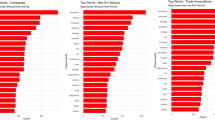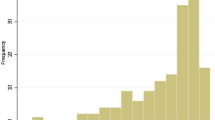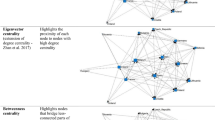Abstract
The literature on circular economy (CE) is growing significantly. Although the concept emerged in the 1970s, it is only very recently that it has gained interest in the scientific community. However, little is known about its genealogy, how the international community was formed, and how concepts were approached and developed by mobilizing different theoretical approaches, especially in humanities and social sciences. This study fills this gap by shedding light on the recent developments in the field from a regional perspective. We used computer-assisted methods (natural language processing, topic modeling, geoparsing, scientometrics, and computational linguistics) on textual data to capture the field’s framework evolution, highlight main topics, identify key drivers, map the geography of knowledge production, and scrutinize the numerous types of the spatial proximities waved between its actors. To our knowledge, this is the first attempt to trace the geographic genealogy of CE using large-scale textual data to produce in-depth knowledge regarding the spatiotemporal genesis of the field by unpacking how closed-loop systems are analyzed across regions, worldwide.







Similar content being viewed by others
Notes
For this study, we used a python version of 3.11 on a MacBook Pro with 16 GB of RAM and i7 quadcore processor. Code execution time was estimated to 42.469 s. Notice that the timeframe includes only (i) reading the data, (ii) cleaning the data, (iii) augmenting the data, and (iv) extract topics from the corpora.
References
Wackernagel M, Rees W (1998) Our ecological footprint: reducing human impact on the earth, vol. 9. New society publishers, Gabriola
Heinberg R (2007) Peak everything. Gabriola Island, Gabriola
Loiseau E et al (2016) Green economy and related concepts: an overview. J Clean Prod 139:361–371
Jacobs M (2013) Green growth. The handbook of global climate and environment policy, pp 197–214
Morseletto P (2020) Targets for a circular economy. Resour, Conserv Recycl 153:104553. https://doi.org/10.1016/j.resconrec.2019.104553
Geissdoerfer M, Savaget P, Bocken NMP, Hultink EJ (2017) The circular economy – a new sustainability paradigm? J Clean Prod 143:757–768. https://doi.org/10.1016/j.jclepro.2016.12.048
Ramakrishna S, Hu W, Jose R (2022) Sustainability in numbers by data analytics. Circ Econ Sust Aug. https://doi.org/10.1007/s43615-022-00201-w
Hachaichi M (2022) Cities: Allocating climate change responsibilities at planetary scale. Urban Clim 46:101329. https://doi.org/10.1016/j.uclim.2022.101329
Ramakrishna S, Pervaiz M, Tjong J, Ghisellini P, Sain MM (2022) Low-carbon materials: genesis, thoughts, case study, and perspectives. Circ Econ Sust 2(2):649–664. https://doi.org/10.1007/s43615-021-00135-9
Hachaichi M, Baouni T (2021) Virtual carbon emissions in the big cities of middle-income countries. Urban Clim 40:100986. https://doi.org/10.1016/j.uclim.2021.100986
Hachaichi M, Egieya J (2022) Water-food-energy nexus in global cities: solving urban challenging interdependencies together. In Rev, preprint. https://doi.org/10.21203/rs.3.rs-1956052/v1
Hachaichi M, Kazak JK, Baouni T (2020) Evaluating City Carbon Carrying Capacity: How many people can Algiers sustain?. Algerian Journal of Environmental Science and Technology 6(3)
Hachaichi M (2022) Reshaping modern urban models with the global environmental ceiling: What, When, How, and Why? - preprint
Ramakrishna S, Jose R (2022) Principles of materials circular economy. Matter 5(12):4097–4099. https://doi.org/10.1016/j.matt.2022.11.009
Hachaichi M (2019) The carbon footprint model as a plea for cities towards energy-transition: the case of Algiers-Algeria. https://doi.org/10.5281/zenodo.2702586
Hachaichi M, Baouni T (2020) Downscaling the planetary boundaries (Pbs) framework to city scale-level: De-risking MENA region’s environment future. Environ Sustain Indic 5:100023. https://doi.org/10.1016/j.indic.2020.100023
Tan J, Tan FJ, Ramakrishna S (2022) Transitioning to a circular economy: a systematic review of its drivers and barriers. Sustainability 14(3):3. https://doi.org/10.3390/su14031757
Blomsma F, Brennan G (2017) The emergence of circular economy: a new framing around prolonging resource productivity. J Ind Ecol 21(3):603–614. https://doi.org/10.1111/jiec.12603
Kirchherr J, Reike D, Hekkert M (2017) Conceptualizing the circular economy: an analysis of 114 definitions. Resour Conserv Recycl 127:221–232. https://doi.org/10.1016/j.resconrec.2017.09.005
Zhu Q, Geng Y, Lai K (2010) Circular economy practices among Chinese manufacturers varying in environmental-oriented supply chain cooperation and the performance implications. J Environ Manage 91(6):1324–1331. https://doi.org/10.1016/j.jenvman.2010.02.013
Bourdin S, Galliano D, Gonçalves A (2021) Circularities in territories: opportunities & challenges. Eur Plan Stud 30(7):1183–1191. https://doi.org/10.1080/09654313.2021.1973174
De Pascale A, Arbolino R, Szopik-Depczyńska K, Limosani M, Ioppolo G (2021) A systematic review for measuring circular economy: the 61 indicators”. J Clean Prod 281:124942. https://doi.org/10.1016/j.jclepro.2020.124942
Balland PA, Boschma R, Frenken K (2022) Proximity, innovation and networks: a concise review and some next steps. Handbook of Proximity Relations, pp 70–80
Rejeb A, Rejeb K, Zailani S, Kayikci Y, Keogh JG (2022) Examining knowledge diffusion in the circular economy domain: a main path analysis. Circ Econ Sust. https://doi.org/10.1007/s43615-022-00189-3
Tapia C, Bianchi M, Pallaske G, Bassi AM (2021) Towards a territorial definition of a circular economy: exploring the role of territorial factors in closed-loop systems. Eur Plan Stud 29(8):1438–1457. https://doi.org/10.1080/09654313.2020.1867511
Schöggl J-P, Stumpf L, Baumgartner RJ (2020) The narrative of sustainability and circular economy - a longitudinal review of two decades of research. Resour, Conserv Recycl 163:105073. https://doi.org/10.1016/j.resconrec.2020.105073
Khitous F, Strozzi F, Urbinati A, Alberti F (2020) A systematic literature network analysis of existing themes and emerging research trends in circular economy. Sustainability 12(4):1633. https://doi.org/10.3390/su12041633
Goyal S, Chauhan S, Mishra P (2021) Circular economy research: a bibliometric analysis (2000–2019) and future research insights. J Clean Prod 287:125011. https://doi.org/10.1016/j.jclepro.2020.125011
Chowdhary KR (2020) Natural language processing. In Fundamentals of Artificial Intelligence, K. R. Chowdhary, Ed. New Delhi: Springer India, 603–649. https://doi.org/10.1007/978-81-322-3972-7_19
Vayansky I, Kumar SAP (2020) A review of topic modeling methods. Inf Syst 94:101582. https://doi.org/10.1016/j.is.2020.101582
Gelernter J, Balaji S (2013) An algorithm for local geoparsing of microtext. GeoInformatica 17(4):635–667. https://doi.org/10.1007/s10707-012-0173-8
Grishman R (1986) Computational linguistics: an introduction. Cambridge University Press, Cambridge
Cuyala S (2016) The spatial diffusion of geography: a bibliometric analysis of ECTQG conferences (1978–2013). Cybergeo: Eur J Geogr https://doi.org/10.4000/cybergeo.27671
Kirchherr J (2022) Bullshit in the sustainability and transitions literature: a provocation. Circ Econ Sust. https://doi.org/10.1007/s43615-022-00175-9
Kneese AV (1988) The economics of natural resources. Popul Dev Rev 14:281–309. https://doi.org/10.2307/2808100
Lieder M, Rashid A (2016) Towards circular economy implementation: a comprehensive review in context of manufacturing industry. J Clean Prod 115:36–51. https://doi.org/10.1016/j.jclepro.2015.12.042
Yuan Z, Bi J, Moriguichi Y (2006) The circular economy: a new development strategy in China. J Ind Ecol 10(1–2):4–8. https://doi.org/10.1162/108819806775545321
MacArthur E (2013) Towards the circular economy. J Ind Ecol 2(1):23–44
Morseletto P (2020) Restorative and regenerative: exploring the concepts in the circular economy. J Ind Ecol 24(4):763–773. https://doi.org/10.1111/jiec.12987
Raes J, van Ast L (2020) Financing circularity: demystifying finance for circular economies. UNEP Finance Initiative, Geneva
Brydges T (2021) Closing the loop on take, make, waste: investigating circular economy practices in the Swedish fashion industry. J Clean Prod 293:126245. https://doi.org/10.1016/j.jclepro.2021.126245
Mihai F-C et al (2022) Plastic pollution, waste management issues, and circular economy opportunities in rural communities. Sustainability 14(1):20. https://doi.org/10.3390/su14010020
Korhonen J, Honkasalo A, Seppälä J (2018) Circular economy: the concept and its limitations. Ecol Econ 143:37–46. https://doi.org/10.1016/j.ecolecon.2017.06.041
Sharma S, Basu S, Shetti NP, Aminabhavi TM (2020) Waste-to-energy nexus for circular economy and environmental protection: recent trends in hydrogen energy. Sci Total Environ 713:136633. https://doi.org/10.1016/j.scitotenv.2020.136633
Gallego-Schmid A, Chen H-M, Sharmina M, Mendoza JMF (2020) Links between circular economy and climate change mitigation in the built environment. J Clean Prod 260:121115. https://doi.org/10.1016/j.jclepro.2020.121115
Invernizzi DC, Locatelli G, Velenturf A, Love PED, Purnell P, Brookes NJ (2020) Developing policies for the end-of-life of energy infrastructure: coming to terms with the challenges of decommissioning. Energy Policy 144:111677. https://doi.org/10.1016/j.enpol.2020.111677
Merli R, Preziosi M, Acampora A (2018) How do scholars approach the circular economy? A systematic literature review. J Clean Prod 178:703–722
Maaß O, Grundmann P (2018) Governing Transactions and interdependences between linked value chains in a circular economy: the case of wastewater reuse in Braunschweig (Germany). Sustainability 10(4):1125. https://doi.org/10.3390/su10041125
Alamerew YA, Kambanou ML, Sakao T, Brissaud D (2020) A multi-criteria evaluation method of product-level circularity strategies. Sustainability 12(12):5129. https://doi.org/10.3390/su12125129
Bassi AM, Bianchi M, Guzzetti M, Pallaske G, Tapia C (2021) Improving the understanding of circular economy potential at territorial level using systems thinking. Sustain Prod Consum 27:128–140. https://doi.org/10.1016/j.spc.2020.10.028
Euopean Commission (2020) New circular economy action plan. European Commission - European Commission. https://ec.europa.eu/commission/presscorner/detail/en/ip_20_420 (accessed May 20, 2022)
Wijkman A, Skånberg K (2015) The circular economy and benefits for society. Club of Rome
Karimzadeh M, Pezanowski S, MacEachren AM, Wallgrün JO (2019) GeoTxt: a scalable geoparsing system for unstructured text geolocation. Trans GIS 23(1):118–136. https://doi.org/10.1111/tgis.12510
Blei DM (2012) Probabilistic topic models. Commun ACM 55(4):77–84. https://doi.org/10.1145/2133806.2133826
Falush D, Stephens M, Pritchard JK (2003) Inference of population structure using multilocus genotype data: linked loci and correlated allele frequencies. Genetics 164(4):1567–1587
Pritchard JK, Stephens M, Donnelly P (2000) Inference of population structure using multilocus genotype data. Genetics 155(2):945–959. https://doi.org/10.1093/genetics/155.2.945
Huang B (Ed) (2017) Comprehensive geographic information systems (1st edition)
Blondel VD, Guillaume J-L, Lambiotte R, Lefebvre E (2008) Fast unfolding of communities in large networks. J Stat Mech 2008(10):P10008. https://doi.org/10.1088/1742-5468/2008/10/P10008
Dugué N, Perez A (2015) Directed Louvain : maximizing modularity in directed networks,” Université d’Orléans, Research Report. Accessed: Jul. 16, 2022. [Online]. Available: https://hal.archives-ouvertes.fr/hal-01231784
Traag VA, Waltman L, van Eck NJ (2019) From Louvain to Leiden: guaranteeing well-connected communities. Sci Rep 9(1)Art. no. 1. https://doi.org/10.1038/s41598-019-41695-z.
Ueno K (2001) Current status of home electric appliances recycling in Japan. J Jpn Inst Energy 80:1100-1107
Dajian Z (2004) Towards a closed-loop materials economy. Chin J Popul Resour Environ 2(1):9–12. https://doi.org/10.1080/10042857.2004.10677342
Nikolaou IE, Jones N, Stefanakis A (2021) Circular economy and sustainability: the past, the present and the future directions. Circ Econ Sust 1(1):1–20. https://doi.org/10.1007/s43615-021-00030-3
Govindan K, Hasanagic M (2018) A systematic review on drivers, barriers, and practices towards circular economy: a supply chain perspective. Int J Prod Res 56(1–2):278–311. https://doi.org/10.1080/00207543.2017.1402141
Sassanelli C, Rosa P, Rocca R, Terzi S (2019) Circular economy performance assessment methods: a systematic literature review. J Clean Prod 229:440–453. https://doi.org/10.1016/j.jclepro.2019.05.019
Cosgrove WJ, Rijsberman FR (2014) World water vision: making water everybody’s business. London: Routledge https://doi.org/10.4324/9781315071763
Gleeson T et al (2020) The water planetary boundary: interrogation and revision. One Earth 2(3):223–234. https://doi.org/10.1016/j.oneear.2020.02.009
Davidson DJ (2019) Exnovating for a renewable energy transition. Nat Energy 4(4):256. https://doi.org/10.1038/s41560-019-0369-3
Rehman A, Ma H, Ozturk I, Ulucak R (2022) Sustainable development and pollution: the effects of CO2 emission on population growth, food production, economic development, and energy consumption in Pakistan. Environ Sci Pollut Res 29(12):17319–17330. https://doi.org/10.1007/s11356-021-16998-2
World Bank (2022) Cities and GDP. World Bank. https://www.worldbank.org/en/topic/urbandevelopment/overview (accessed May 20, 2022)
Wang N, Lee JCK, Zhang J, Chen H, Li H (2018) Evaluation of urban circular economy development: an empirical research of 40 cities in China. J Clean Prod 180:876–887. https://doi.org/10.1016/j.jclepro.2018.01.089
Olabi AG (2019) Circular economy and renewable energy. Energy 181:450–454. https://doi.org/10.1016/j.energy.2019.05.196
Rodriguez-Anton JM, Rubio-Andrada L, Celemín-Pedroche MS, Alonso-Almeida MDM (2019) Analysis of the relations between circular economy and sustainable development goals. Int J Sust Dev World 26(8):708–720. https://doi.org/10.1080/13504509.2019.1666754
Ferronato N, Rada EC, Gorritty Portillo MA, Cioca LI, Ragazzi M, Torretta V (2019) Introduction of the circular economy within developing regions: a comparative analysis of advantages and opportunities for waste valorization. J Environ Manag 230:366–378. https://doi.org/10.1016/j.jenvman.2018.09.095
De Meo P, Ferrara E, Fiumara G, Provetti A (2011) Generalized Louvain method for community detection in large networks. In 2011 11th International Conference on Intelligent Systems Design and Applications 88–93. https://doi.org/10.1109/ISDA.2011.6121636
SverkoGrdic Z, KrstinicNizic M, Rudan E (2020) Circular economy concept in the context of economic development in EU countries. Sustainability 12(7):3060. https://doi.org/10.3390/su12073060
Christis M, Athanassiadis A, Vercalsteren A (2019) Implementation at a city level of circular economy strategies and climate change mitigation – the case of Brussels. J Clean Prod 218:511–520. https://doi.org/10.1016/j.jclepro.2019.01.180
Esa MR, Halog A, Rigamonti L (2017) Developing strategies for managing construction and demolition wastes in Malaysia based on the concept of circular economy. J Mater Cycles Waste Manag 19(3):1144–1154. https://doi.org/10.1007/s10163-016-0516-x
Pavel S (2018) Circular economy: the beauty of circularity in value chain,” Social Science Research Network, Rochester, NY, SSRN Scholarly Paper 3396260. Accessed: May 30, 2022. [Online]. Available: https://papers.ssrn.com/abstract=3396260
Dagilienė L, Varaniūtė V, Bruneckienė J (2021) Local governments’ perspective on implementing the circular economy: a framework for future solutions. J Clean Prod 310:127340. https://doi.org/10.1016/j.jclepro.2021.127340
OECD () Development co-operation recorded in national budgets. Organisation for Economic Co-operation and Development, Paris. Accessed: Jul. 21, 2022. [Online]. Available: https://www.oecd-ilibrary.org/development/development-co-operation-report-2017/development-co-operation-recorded-in-national-budgets_dcr-2017-graph35-en
Sarvajayakesavalu S (2015) Addressing challenges of developing countries in implementing five priorities for sustainable development goals. Ecosyst Health Sustain 1(7):1–4. https://doi.org/10.1890/EHS15-0028.1
Belmin C, Hoffmann R, Pichler P-P, Weisz H (2022) Fertility transition powered by women’s access to electricity and modern cooking fuels. Nat Sustain 5(3)Art. no. 3. https://doi.org/10.1038/s41893-021-00830-3
Tucho GT, Kumsa DM (2020) Challenges of achieving sustainable development goal 7 from the perspectives of access to modern cooking energy in developing countries. Front Energy Res 8. Accessed: Jul. 22, 2022. [Online]. Available: https://www.frontiersin.org/articles/https://doi.org/10.3389/fenrg.2020.564104
Acknowledgements
The authors would like to thank Dr. Fabien Nadou for his suggestions and comments on the previous version of the article.
Author information
Authors and Affiliations
Contributions
M. Hachaichi: study design, data collection, analysis, article writing. S. Bourdin: study design and supervision.
Corresponding author
Ethics declarations
Ethical Approval and Consent to Participate
Not applicable.
Consent for Publication
Not applicable.
Competing interests
The authors declare no competing interests.
Rights and permissions
Springer Nature or its licensor (e.g. a society or other partner) holds exclusive rights to this article under a publishing agreement with the author(s) or other rightsholder(s); author self-archiving of the accepted manuscript version of this article is solely governed by the terms of such publishing agreement and applicable law.
About this article
Cite this article
Hachaichi, M., Bourdin, S. Wheels Within Wheels: Mapping the Genealogy of circular Economy using Machine Learning. Circ.Econ.Sust. 3, 2061–2081 (2023). https://doi.org/10.1007/s43615-023-00260-7
Received:
Accepted:
Published:
Issue Date:
DOI: https://doi.org/10.1007/s43615-023-00260-7






